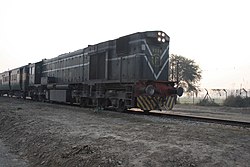Samjhauta Express
| Samjhauta Express | ||||||||||||||||||||||||||||||||||||||||||||||||||||||||||||||||||||
|---|---|---|---|---|---|---|---|---|---|---|---|---|---|---|---|---|---|---|---|---|---|---|---|---|---|---|---|---|---|---|---|---|---|---|---|---|---|---|---|---|---|---|---|---|---|---|---|---|---|---|---|---|---|---|---|---|---|---|---|---|---|---|---|---|---|---|---|---|

Pakistani Rakes of Samjhauta Express
|
||||||||||||||||||||||||||||||||||||||||||||||||||||||||||||||||||||
| Overview | ||||||||||||||||||||||||||||||||||||||||||||||||||||||||||||||||||||
| Termini |
Lahore Delhi |
|||||||||||||||||||||||||||||||||||||||||||||||||||||||||||||||||||
| Stations | Amritsar, Lahore | |||||||||||||||||||||||||||||||||||||||||||||||||||||||||||||||||||
| Operation | ||||||||||||||||||||||||||||||||||||||||||||||||||||||||||||||||||||
| Operator(s) |
Pakistan Railways Indian Railways |
|||||||||||||||||||||||||||||||||||||||||||||||||||||||||||||||||||
| Technical | ||||||||||||||||||||||||||||||||||||||||||||||||||||||||||||||||||||
| Track gauge | Indian Gauge 5 ft 6 in | |||||||||||||||||||||||||||||||||||||||||||||||||||||||||||||||||||
|
||||||||||||||||||||||||||||||||||||||||||||||||||||||||||||||||||||
The Samjhauta Express (Hindi: समझौता एक्सप्रेस, Urdu: سمجھوتا اکسپريس Punjabi language: ਸਮਝੌਤਾ ਐਕਸਪ੍ਰੈਸ / سمجھوتا اکسپريس ) commonly called the Friend Express, is a twice-weekly train – Tuesdays and Fridays – that runs between Delhi and Attari in India and Lahore in Pakistan. The word Samjhauta means "agreement", "accord" and "compromise" in both Hindi and Urdu.
Until the reopening of the Thar Express, this was the only rail connection between the two countries. The train was started on 22 July 1976 following the Shimla Agreement and ran between Amritsar and Lahore, a distance of about 42 km. Following disturbances in Punjab in the late eighties, due to security reasons Indian Railways decided to terminate the service at Attari, where customs and immigration clearances take place. On 14 April 2000, in an agreement between Indian Railways and Pakistan Railways (PR), the distance was revised to cover just under three km.
It was a daily train when the service started, and changed to a bi-weekly schedule in 1994. Earlier the rakes were returned to the home country the same day but later in 2000 the rake remained overnight at that location.
...
Wikipedia
